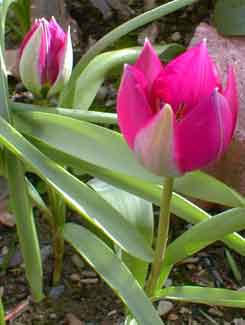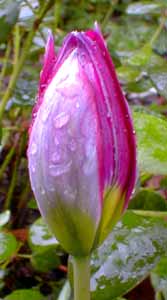
'Persian Pearl'
Crocus Tulip
"Perhaps the tulip knows the fickleness
Of Fortune's smile, for on her stalk's green shaft
She bears a wine-cup through the wilderness."
-Hafiz (1325-1389)
tr. by Gertrude Bell
tr. by Gertrude Bell
Ten Tulipa humilis 'Persian Pearl' bulbs were planted Autum 2003 in front of the 'Whisperingrose' dwarf rhody near the 'Jelena' Witchhazel. These were placed six or eight inches deep, three to five inches apart.
 It is easy to add another layer of bulbs that only need to be planted a scant two or three inches down, baring in mind how little these tulips can be, so that sharing space with anything larger than themselves might not work well. In our zone, crocuses are finished flowering by the time 'Pearsian Pearl' is getting going, so they need not conflict to layer them together.
It is easy to add another layer of bulbs that only need to be planted a scant two or three inches down, baring in mind how little these tulips can be, so that sharing space with anything larger than themselves might not work well. In our zone, crocuses are finished flowering by the time 'Pearsian Pearl' is getting going, so they need not conflict to layer them together.They were formerly named T. pulchella & still often mislabeled as such. The current species name alludes to it being one of the shortest of tulips. Most varieties are five or six inches tall, & 'Persian Pearl' is reportedly often a scant four inches. But given the widely varied habit of various strains from grower to grower, it wasn't too surprising that our 'Persian Pearls' grew as much as eight inches high, taller than is average.
We have two other clones of T. humilis var. violacea which do not have special cultivar names but which are completely different from one another. These others have separate pages provided to them, 'Violacea #1' being the earliest-blooming & less than five inches tall, & 'Violacea #2' starting to flower ahead of "Persian Pearl" but after 'Violacea #1,' & much the smallest of the three strains at only three our four inches tall.
The dwarf stature & pointed flower petals lends all varieties of T. humilis the common name "Crocus Tulips," due foremost to their usually being about as short as crocuses, but also because some of them bloom as early as snow-crocuses, as in the case of the strain we've designated 'Violacea #1.'
'Persian Pearl' is magenta with pearly white streaks on the outermost petals, violet-purple on the interior, with a yellow star at the heart. The other two strains ('Violacea' #1 & #2) lack the silvery streaking on the outside of the outermost petals. On a very sunny day when the trulips are fully opened the silver outer petals will be invisible, but on many days they will look appear as in the first mid-March photo only partially opened. The second photo taken on a rainy overcast days later in March shows the flower having re-closed itself into bud-like shape, when primarily the silver shows.
'Persian Pearl' is one of several cultivated variants of this wild botanical. They are not hybrids but are selected forms. Since they are true botanicals, they are apt to naturalize in the garden & seed true to the parents. But strains planted in proximity to one another crosspollinate at will, resulting intermediate forms for this greatly variable species.
'Persian Pearl' was formerly difficult to obtain except from specialty suppliers, but beginning in 2003 it reached mass production & is presently one of the more easily obtained botanical tulips.
Bloom times will vary depending on strain & garden conditions. Bulbs sold as 'Persian Pearl' can bloom as early as March or as late as May, with April their primary period. Ours have buds showing magenta color at the seams before mid-March, with full blooms for the last half of the month & long into April.
The narrow foliage which is also rather decorative appears in February & is red-rimmed when it first emerges, though the red leaf-edging soon fades to geen, & isn't found on every strain of 'Persian Pearl.'
These tulips are ideal for rockery ledges or the front edges of any well-draining sun-garden or in containers. They will bloom in part shade but really should have fuller sunlight in order to naturalize.